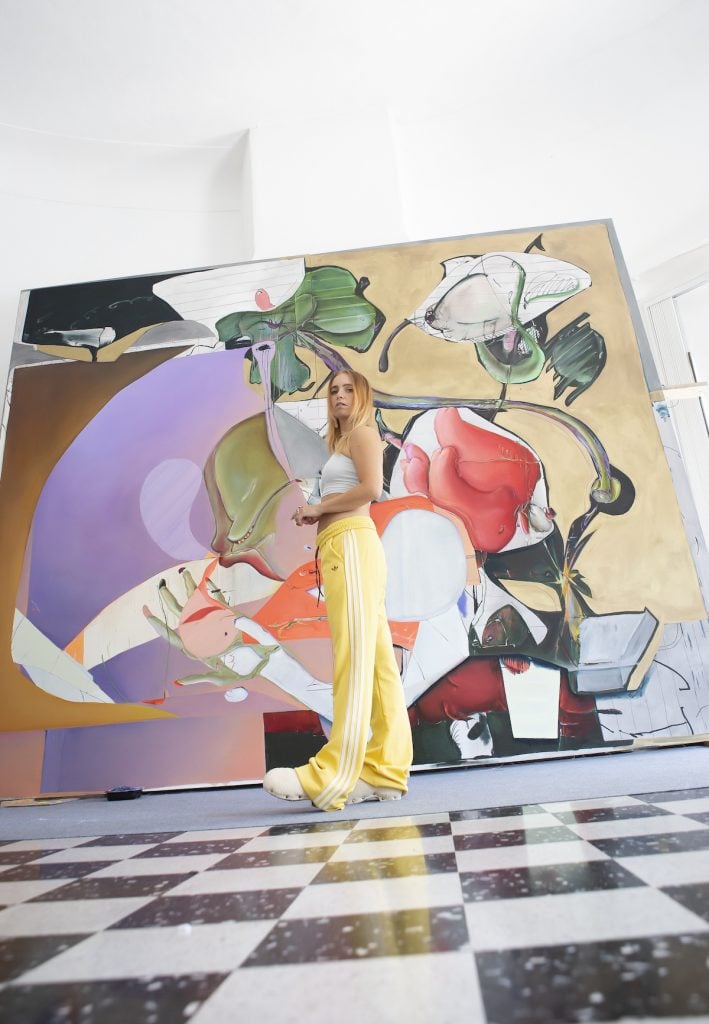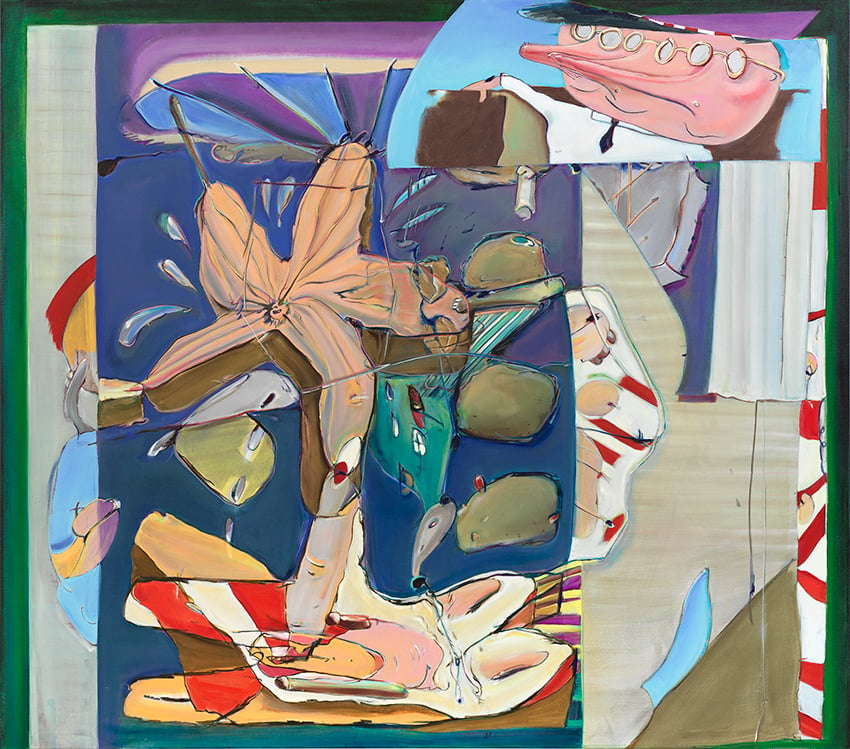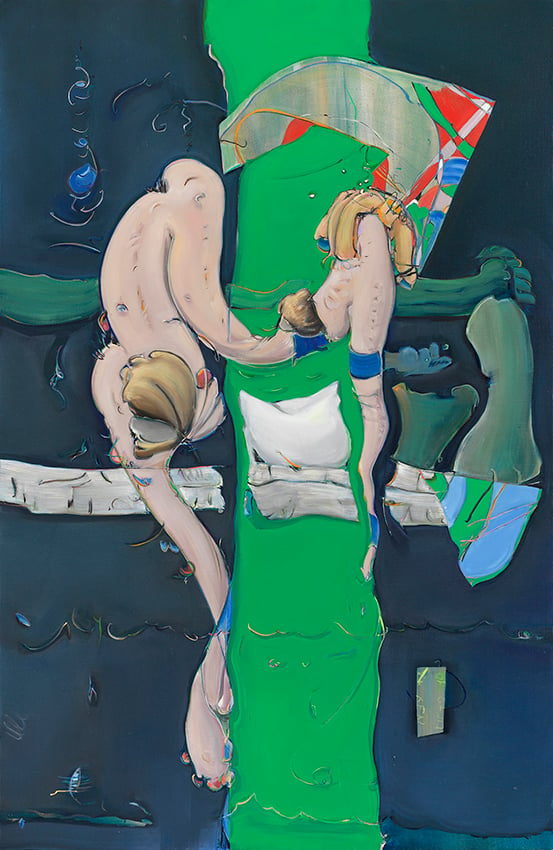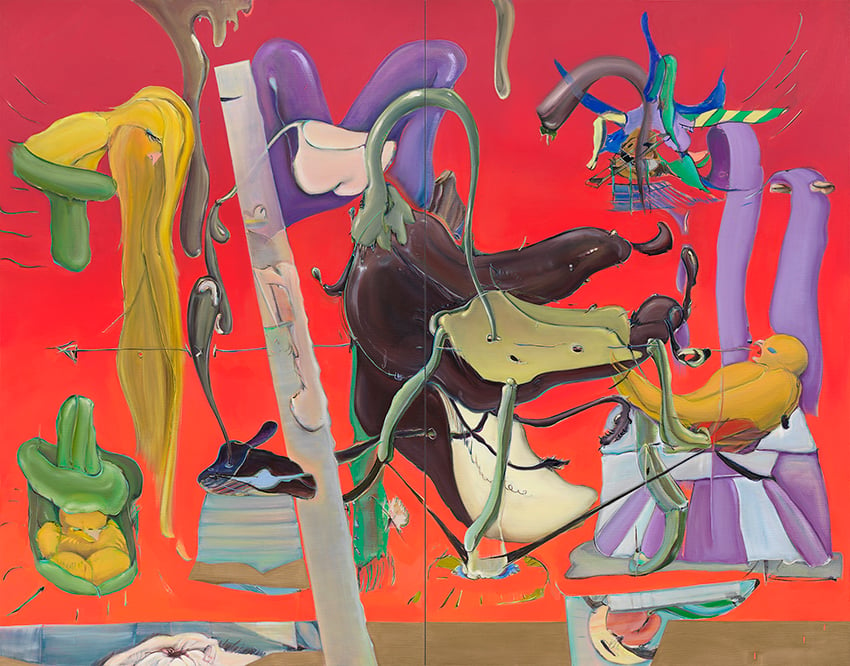Artists
Stefanie Heinze Paints Richly Ambiguous Worlds. Collectors Are Obsessed
After relocating from Berlin to Brooklyn, the 36-year-old artist is working on a solo show for next year.

After relocating from Berlin to Brooklyn, the 36-year-old artist is working on a solo show for next year.

Taylor Dafoe

Most abstract paintings are equivocal, but Stefanie Heinze’s canvases, with their contorted forms that tease but never quite coalesce into recognizability, are like Rorschach tests: so ambiguous that the only intentions they reveal are those that viewers project onto them.
And people tend to project a lot onto them.
“I see all different kinds of reactions,” the German-born artist said in a recent video interview. Restless like her compositions, Heinze crossed and uncrossed her legs at a kitchen table in her Brooklyn apartment, where she recently moved after years of working in her hometown of Berlin. Breakfast is next to her; so is a well-worn box of tarot cards—a special interest of late for the 36-year-old. “It makes me really happy that they’re not just read by one group of people.”
Indeed, one of the great joys in looking at Heinze’s is thinking about how others might interpret it all—the twisted limbs and deformed organs, the oozing secretions and blobs of color. Just imagine her five- or six-foot-tall canvases in front of, say, a Freudian academic, a second grader, or someone tripping on acid. What would they see?

Stefanie Heinze, Der Professor (2020). Courtesy of the artist and Petzel, New York.
“Stefanie’s uncanny representation of the body makes me think of morphing organisms, playing with the boundaries of figuration and abstraction,” said gallerist Friedrich Petzel, who began representing Heinze in 2019. The dealer’s introduction to the artist came just two years earlier, when she had a solo show at Mary Boone Gallery in New York. He was “struck by the fluidity of her painting” and the “new forms and vocabularies of representation” in them.
Heinze’s second solo show with Petzel, set to take place this coming May, will likely arrive to more fanfare than her first, “Frail Juice,” which opened in 2020. Since her debut at the gallery, the artist’s work has become a hot commodity for collectors, particularly those on the secondary market. Her paintings have appeared at auction five times, all this year, and in each case, they exceeded their pre-sale estimates.
Earlier this month, for instance, Heinze’s 2020 painting Third Date sold for $239,000 at Christie’s 21st Century Evening Sale in New York, tripling its high estimate. A week later at Sotheby’s, her 2019 artwork Vim was expected to fetch between $100,000 and $150,000. It went for $203,000.

Stefanie Heinze, Third Date (2020). Courtesy of the artist and Petzel, New York.
The capriciousness of Heinze’s paintings might have you thinking they were made quickly, but the opposite is true. Most of her compositions begin as drawings, which she makes in a small book, usually on the go or while multitasking. Then comes the part where she meticulously transfers them to canvas in the studio, which can take days or weeks.
It’s a heavy process, Heinze explained, despite the ribald humor that frequently comes out of it. “It’s very serious, in some ways, how I engage with the process and how I translate it. It’s not just something that I paint.” For her, she continued, “it’s a form of engagement with blankness, with fear, with uncertainty.”
Heinze doesn’t set out with a specific image in mind, and she’s not insistent on nailing one along the way. “I have no idea what it’s going to look like,” she explained. “I figure it out while I do it and I just trust the paint itself.” In the end, she isn’t any surer of what she’s created than we as audiences are. “That’s a very funny thought, that we as artists have everything under control and know exactly what we’re doing,” she mused.

Stefanie Heinze, A Hollow Place in a Solid Body (2020). Courtesy of the artist and Petzel, New York.
Like Petzel, who sees in Heinze’s canvases a connection to “Roberto Matta’s undefined pictorial space,” many who spend time with her work reach for art historical allusions for grounding. Those touchpoints are certainly there if you want them to be: the drooping biomorphs of Salvador Dalí, the matter-of-fact surrealism of New Leipzig School artists like Neo Rauch, the cartoonish wit of Philip Guston (who was the subject of Heinze’s undergrad thesis). One critic described her work as “mutant, dripping Bellmer-esque forms.” The artist’s eyes rolled when this came up in the interview.
When asked if there are other painters who have influenced her work, Heinze said, simply, “No.”
“It’s just not how I work. I love to go see painting and I love a lot of painters, but I don’t work after them.” While many artists evoke the canon in an effort to insert themselves into it, she takes an opposite approach: “I respect it in a way that I distance myself from it.”
“There are so many things we’re trained to see,” she added. “I try to put it in a way that’s not for the trained eye.”
More than art history, what occupies the artist’s mind these days are quotidian pleasures—doing her nails, watching women’s basketball—and esoteric ones like tarot. She’s particularly interested in the history of the cards and their capacity for aiding personal enlightenment.
Near the end of the interview, amid a discussion about the open-endedness of her work, Heinze’s eyes landed on the deck next to her. She paused. “Isn’t it cool,” she said, that centuries ago, “some people made some cards with some little images on them and now they give themselves over to the universe?”
More Trending Stories:
Art Critic Jerry Saltz Gets Into an Online Skirmish With A.I. Superstar Refik Anadol
The Old Masters of Comedy: See the Hidden Jokes in 5 Dutch Artworks
A Royal Portrait by Diego Velázquez Heads to Auction for the First Time in Half a Century
How Do You Make $191,000 From a $4 Painting? You Don’t
In Her L.A. Debut, South Korean Artist Guimi You Taps Into the Sublimity of Everyday Life
Two Rare Paintings by Sienese Master Pietro Lorenzetti Come to Light After a Century in Obscurity